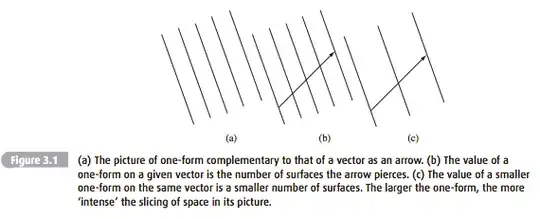Suppose you're going to buy some flour and sugar. You can represent the amount of flour and sugar as a two-dimensional vector: one component says how much flour you're buying, and the other says how much sugar. If you want to know how much money you need, you need to know the prices. That, too, can be represented by a two-dimensional vector. We can think of price as being the result of combining these two vectors by taking, for each substance, the price of that substance times the amount of that substance, and then adding up the result of all those multiplications.
Suppose we're given any vector space with finite dimension $n$. By definition of "dimension", there is some set of $n$ vectors $v_1, v_2 ...v_n$ that forms a basis for that space. If we want to take each vector to a scalar, then we have some function $f:$v$\rightarrow c$, where v is a vector and $c$ is a scalar. If $f$ is linear, then it is uniquely determined by its actions on the basis vectors: if we know $f(v_i)$ for all $i$ from 1 to $n$, then we know $f(v)$ for any $v$. That means that $f$ can be characterized by a list of its outputs: if we have $[f(v_1),f(v_2)...f(v_n)]$, then we know what $f$ is. So if we think of a vector as "a list of n numbers", then $f$ is acting like a vector. This is what the dual space is: it's the set of all linear functions from a vector space to the set of scalars. The dual space is itself a vector space, and the original vector space acts as the dual of the dual: that is, instead of thinking of each member of the dual space as a function acting on the original vectors, we can think of the original vectors as functions acting on the dual vectors. So given $v$ and $f$, $v(f)$ gives a scalar. So the original space and the dual space act in isomorphic ways: one can be considered to be acting on the other. Furthermore, they have the same dimension, thus they are the same "size" in some sense, and we could, if we wanted, "pair" each vector in one with a vector in the other.
Of course, a list of prices or quantities of flour and sugar is much different from a relativistic vector. Such a list doesn't represent anything in spacetime, and each component represents something completely different, while the components in relativity are supposed to be related through transformations such as rotations and Lorentz transforms. And prices and quantities represent completely different things. So even though we could pair of quantities with a set of prices, that pairing would be arbitrary: there would be lots of different ways of doing it. We could have a pairing that pairs a pound of flour with 1 dollar/pound. Or we could have a pairing that pairs an ounce of flour with 1 cent/ounce, to take just two examples.
Now suppose we want an operation that takes two elements of the original space, and gives a scalar as output. One way of defining that would be to take the vector that is paired with the first, and apply it to the second. That is, suppose we're given vectors $u$ and $v$ that are both in the original space. We could find what vector in the dual space is paired with $u$, and then apply that to $v$. But remember, the pairing is arbitrary. So we need something that tells us what pairing we're using. That's where the metric comes in. The metric is often given as a function that takes two elements of the original space and gives a scalar as output: $g: (u,v) \rightarrow c$. But it can also be thought of as a function that take a member of the original space as input and gives a member of the dual space as output. It's not quite accurate that the dual vectors are reliant on the metric, but their relationship to the original space is.
